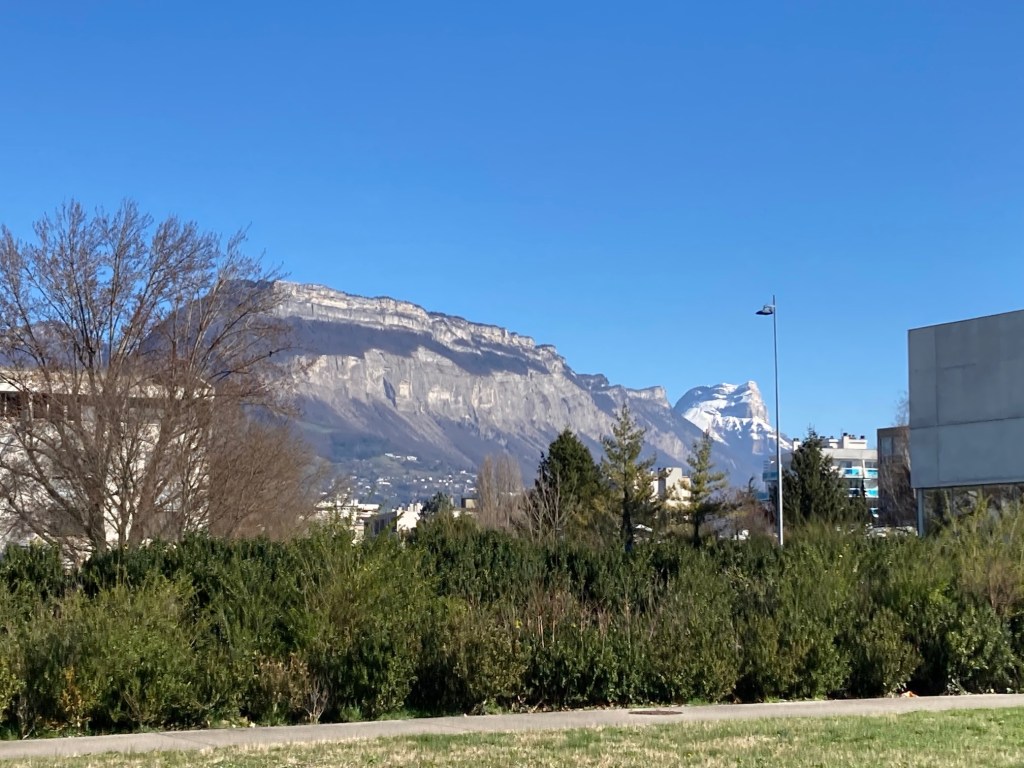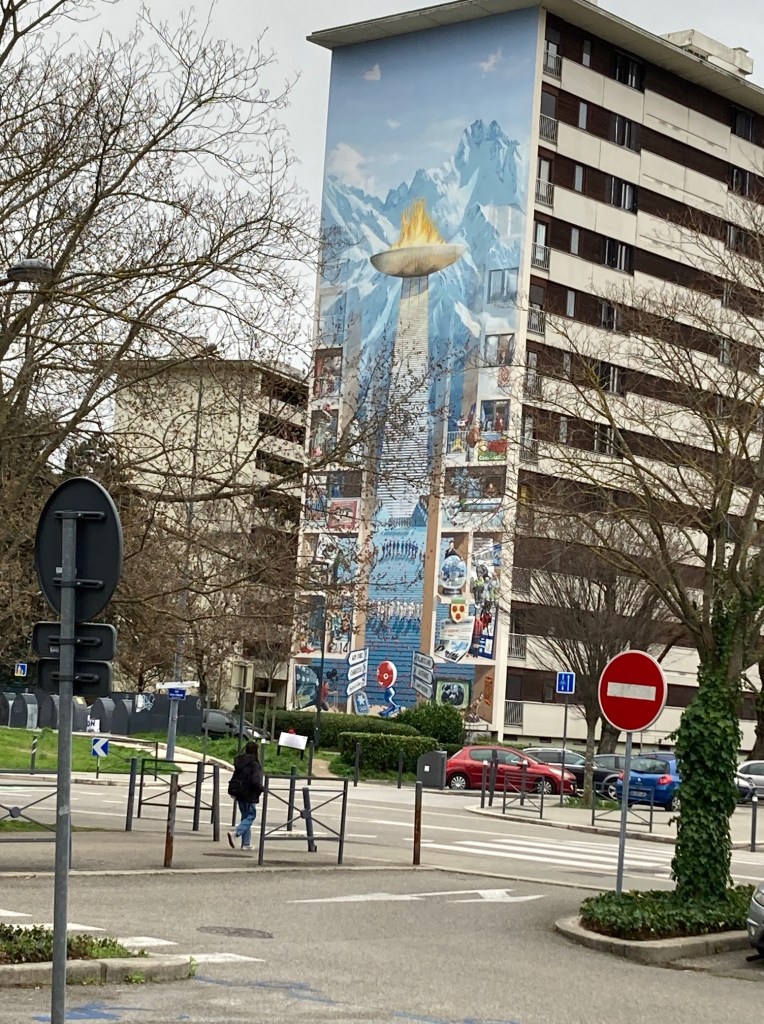Grenoble

We have been in Grenoble for two weeks. Grenoble is a most attractive city in south east France, at the foot of the French Alps, where the river Drac joins the Isère. It is surrounded by three glorious massifs, and is closer to mountains than any city in Europe, with the possible exception of Innsbruck. “At the end of every street, there’s a mountain,” the writer Stendhal famously said about his hometown.

From the chaplaincy apartment, you can see the Vercors mountains. the site of a disastrous uprising in summer 1944. Curiously, the city centre is the flattest city in France. It is a historic city, initially named Cularo by the Romans, and later Gratianopolis; and subsequently became part of the Burgundian kingdom and then of the Holy Roman Empire.The author Stendhal was born here. The city’s services and status were greatly improved when it hosted the Xth Winter Olympics in 1968. Grenoble is now one of France’s leading cities for business and industry, and it boasts a student population of over 60,000, drawn from all over the world
A tour of the historical centre is an easy stroll. I started at the Gallo-Roman enclosure in the rue Lafayette. Between 286 and 293 AD a circular wall with some 39 towers was built by the Emperor Diocletian. But little remains today. Round the corner, Stendhal was born in 1763 at no. 14 rue Jean-Jacques Rousseau.

The nearby Place Grenette was the place for cattle and livestock markets from the 17th century. The rue de Bonne leads to the Place Victor Hugo, an elegant square, created in 1885, with its original chestnut trees and late 19th century facades.

A short walk brings you to the old Trois Dauphins inn, where Napoleon stayed for two nights in March 1815 after his escape from Elba. Across the road is the Jardin de Ville, laid out in 1719. From here a cable car, known as les Oeufs or les Bulles, for its egg-shaped, transparent cabins, whisks passengers across the river Isère and up 260 metres to the Bastille and the Vauban Belvedere. [Not me ! I haven’t been on a cable-car since our scary, unconsidered trip at la Clusaz, when we were on our honeymoon at Annecy in 1975. We subsequently walked back down the mountain.]
From across the river, on the Quai Perrière, there are magnificent views south back across the city to the Vercors and the Bellledonne massifs.

A pedestrian bridge across the river brings you back to the old town, to the Place aux Herbes, where there is a local producers’ market every weekday morning. From where I hurried back to the Place Grenette where I was meeting Susie for coffee. Leaving for another time the 13th century collegiate church of St Andre, with the mausoleum of the Chevalier Bayard. And the Place Notre-Dame with the Notre-Dame cathedral, and the adjacent Musée de l’Ancien Evêché, currently housing an exhibition of mountain photography. Although the weather forecast constantly tells us that rain and snow are on the way, it was a glorious bright, cold day with winter sunshine and brilliant blue skies.

St Marc’s, Grenoble
Susie and I are doing a locum chaplaincy at St Marc’s [Anglican] English-speaking church. We are staying in the church apartment, some 35 minutes walk, or six tram stops. south of the historic centre. St Marc’s is one of the fifty or so Anglican congregations in the Archdeaconry of France. It used to be a joint chaplaincy with Lyon but became independent in 1993. The congregation was financially self-supporting for many years, but struggled after the planting of an American-led ‘International Church’ about fifteen years ago. Finances became very difficult and the last permanent chaplain left in about 2018, since when worship has been sustained by a succession of locum clergy, mainly retired. Susie and I were last here. again as locums, before COVID in May and June 2019.
It was not our first contact with St Marc’s. Our daughter, Joanna, was a member here when she was a student in Grenoble in 1997-98. [She would have been 47 tomorrow, it is her birthday.] She had a good year here; studying at the Institut d’Etudes Politiques, and as part of Round Twenty, an active youth group at St Marc’s with good friends here from Edinburgh and from St Andrews. She lived in the rue Hector Berlioz, just off the Jardin de Ville, with an everyday view of les oeufs rising steadily towards the Bastille.

Both the church and the apartment are on the edge of Villeneuve, an ambitious piece of urban planning, designed by the architect Maurice Novarina and largely built between 1970 and 1983. Mixed housing is arranged around a central park with well-planted trees. Sunday worship is in an ecumenical centre which is shared with the Roman Catholic and, in earlier days, French Protestant churches. It was the earliest such ecumenical centre in France, built I think by the local authority, and is the only one still functioning. It is a spartan concrete building. Word is that ministry in the Roman Catholic section of the building will shortly be taken over by Chemin Neuf, and the first floor will be converted to house the ministry team.

The service is projected on PowerPoint onto the rear wall, and the singing is led by one or other of their two music groups. Many of the hard-working church leaders are English, who have been there for a long time, but the congregation is ethnically and culturally diverse. More than half the congregation are Nigerians, most of them refugees and asylum seekers. They are faithful attenders, but have very limited resources. The cultural and confessional diversity of the congregation is a delight after the predominant monoculture of church life in Edinburgh. But there has been no permanent chaplain here for several years, and however energetic locum clergy may be the consequence is usually a decline in church attendance and in church finances. The prayerful desire at the moment is for a five-year budget which will enable the church to advertise for a permanent, if part-time and part-stipendiary, chaplain. And that in this process the Archdeacon may be more of a help than a hindrance !

In between Sundays
Outwith Sundays, Susie and I have joined a Tuesday morning prayer meeting on Zoom. And have been hosting and leading a Wednesday evening group Living with the Psalmist. We have also been up to Lans en Vercors for a most enjoyable lunch with Elizabeth and Jean-Claude; preceded by forty minutes on the bus up from Sassenage while I try and fight down an attack of acrophobia. [The alternative bus route looks to my nervous eye too vertiginous to attempt.]

And there is the Six Nations. And friends from Lyon and elsewhere are coming to lunch. And I am reading a hair-raising book about the SOE in Albania 1943-45; and a serious theological book by Alan E. Lewis, Between Cross and Resurrection, of which perhaps more another time.
March 2024
Always glad to hear your news and travels
Love Madge
Mrs.Madge E OLBY
Canford
26 Greenways
BECKENHAM Kent
BR3 3NG
020 8650 3844
Mobile: 0775 287 5755
LikeLike
Many thanks, belatedly, Madge. We are enjoying being here, and have been blessed with sunshine and blue skies. I hope all is well with you. Love from us, Chris
LikeLike
Morning, Hope you are both well. I am spreading the word re this pilgrimage: Gaza Ceasefire Pilgrimage | Walk in prayerful solidarity
| | | | | |
|
| | | | Gaza Ceasefire Pilgrimage | Walk in prayerful solidarity
This Lent, a global movement is walking in prayerful solidarity with the people of Gaza. Come, walk with us. |
|
|
Much love, Karen
LikeLike
Many thanks, Karen. The news from Gaza gets steadily worse: tens of thousands of people homeless, bereaved, aggressed by land and air by the Israeli military. And now facing the real threat of starvation. I’ll see if there is a pilgrimage/walk around here. Or possibly back in Edinburgh after Easter. Love, from us, Chris
LikeLike